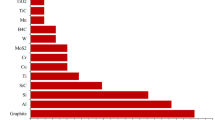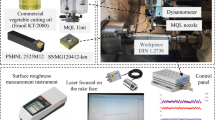Abstract
This study presents the affects of cryogenic treatment on flank wear (Vb) and surface roughness (Ra) in machining 41Cr4 steel with shallow (SCT (15 h at −80 °C)) and deep (DCT (15 h at −196 °C)) cryogenically treated carbide tools. The study revealed that the cryogenic treatment increases the hardness and wear resistance of coated carbide tools and improves the surface roughness, thanks to the changes in the microstructure. The η-phase is approximately 17.5 and 24.64% higher in the shallow and deep cryogenically treated tool's microstructure than in the untreated tool (U). The best machining performance was founded with the deep cryogenically treated cutting tool. Compared to the untreated tool, shallow and deep cryogenic treatment increased the hardness of the cutting tools by approximately 8.66 and 10.17%. Compared to the untreated cutting tool, the deep cryogenically treated tool was less worn at rates ranging from 13.04 to 18.60% and provided a lower average surface roughness between 2.49 and 20.15%. With increasing feed rate and cutting speed, the amount of cutting tool flank wear also increased. While the surface roughness values decreased slightly with increasing cutting speed, the increasing feed rate caused the surface roughness to increase significantly. The analysis of variance results showed that the most significant parameter on the cutting tool flank wear was heat treatment with a rate of 67.34%, and the most influential parameter on the surface roughness was the feed rate with a rate of 96.33%.














Similar content being viewed by others
References
M. Sekmen, M. Günay, and U. Şeker, Effect on Formations of Built-up Edge and Built-up Layer, Surface Roughness of Cutting Speed and Rake Angle in the Machining of Aluminum Alloys, J. Polytech., 2015, 18(3), p 141–148.
D. Karayel, Prediction and Control of Surface Roughness in CNC Lathe Using Artificial Neural Network, J. Mater. Process. Technol., 2009, 209(7), p 3125–3137.
N.A. Özbek, Effects of Cryogenic Treatment Types on the Performance of Coated Tungsten Tools in the Turning of AISI H11 Steel, J. Mater. Res. Technol., 2020, 9(4), p 9442–9456.
N.A. Özbek, Optimization of Flank Wear and Surface Quality in the Turning of 1.2343 Tool Steel Using Carbide Tools Coated via Different Methods, Surf. Topogr.: Metrol. Prop., 2021, 9(2), p 25028. https://doi.org/10.1088/2051-672x/abfd06
O. Özbek and H. Saruhan, The Effect of Vibration and Cutting Zonetemperature on Surface Roughness and Tool Wear Ineco-Friendly MQL Turning of AISI D2, J. Mater. Res. Technol., 2020, 9(3), p 2762–2772.
B. Kursuncu and Y.E. Biyik, Optimization of Cutting Parameters with Taguchi and Grey Relational Analysis Methods in MQL-Assisted Face Milling of AISI O2 Steel, J. Cent. South Univ., 2021, 28(1), p 112–125.
A. Şahinoglu and M. Rafighi, Investigation of Tool Wear, Surface Roughness, Sound Intensity, and Power Consumption during Hard Turning of AISI 4140 Steel Using Multilayer-Coated Carbide Inserts, J. Eng. Res. (Kuwait), 2021, 9(4 B), p 377–395.
H. Gökçe, İ Çiftçi, and H. Demir, Cutting Parameter Optimization in Shoulder Milling of Commercially Pure Molybdenum, J. Braz. Soc. Mech. Sci. Eng., 2018, 40(7), p 1–11.
N. Altan Özbek, O. Özbek, and F. Kara, “Investigation of The Effects of Cryogenic Treatment on AISI H11 Steel,” IMASCON, (Kocaeli), 2018, p 1936–1942.
S. Zhirafar, A. Rezaeian, and M. Pugh, Effect of Cryogenic Treatment on the Mechanical Properties of 4340 Steel, J. Mater. Process. Technol., 2007, 186(1–3), p 298–303.
N.A. Özbek, A. Çiçek, M. Gülesİn, and O. Özbek, Application of Deep Cryogenic Treatment to Uncoated Tungsten Carbide Inserts in the Turning of AISI 304 Stainless Steel, Metall. Mater. Trans. A: Phys. Metall. Mater. Sci., 2016, 47(12), p 6270–6280.
N.A. Özbek, Investigation of the Effects of Cryogenic Treatment Applied on Coated Tungsten Carbide Tools on Machinability of AISI H11 Steel, Duzce Univ. J. Sci. Technol., 2020, 8(2), p 1650–1660.
E. Yıldız and N. Altan Özbek, Effect of Cryogenic Treatment and Tempering Temperature on Mechanical and Microstructural Properties of AISI 431 Steel. Int. J. 3D Print. Technol. Digit. Indu., 2022, 6(1), 74–82.
A. Çiçek, T. Kıvak, E. Ekici, F. Kara, and N. Uçak, Performance of Multilayer Coated and Cryo-Treated Uncoated Tools in Machining of AISI H13 Tool Steel—Part 1: Tungsten Carbide End Mills, J. Mater. Eng. Perform., 2021, 30(5), p 3436–3445.
N. Altan Özbek and O. Özbek, Investigation of the Effects of Shallow Cryogenic Treatment on the Mechanical and Microstructural Properties of 1.2436 Tool Steel, J. Mater. Mechatron.: A (JournalMM), 2022, 3(2), p 151–162.
L.A. Alava, “Improving HSS Tools Performance by Deep Cryogenic Treatment,” Smart Solutions for Metal Cutting, 2009, p 1–9.
E. Nas and N. Altan Özbek, Optimization of the Machining Parameters in Turning of Hardened Hot Work Tool Steel Using Cryogenically Treated Tools. Surface Rev. Lett. 2020, 27(5).
T.V. SreeramaReddy, T. Sornakumar, M. Venkatarama Reddy, and R. Venkatram, Machinability of C45 Steel with Deep Cryogenic Treated Tungsten Carbide Cutting Tool Inserts, Int. J. Refract. Metals Hard Mater., 2009, 27(1), p 181–185. https://doi.org/10.1016/j.ijrmhm.2008.04.007
N.A. Özbek, A. Çiçek, M. Gülesin, and O. Özbek, Application of Deep Cryogenic Treatment to Uncoated Tungsten Carbide Inserts in the Turning of AISI 304 Stainless Steel, Metall. Mater. Trans. A, 2016, 47(12), p 6270–6280.
G. Samtaş and S. Korucu, Multiple Optimisation of Cutting Parameters in Milling of Cryogenically Treated Aluminium 6061–T651 Alloy with Cryogenic and Normal Cutting Inserts, Surf. Topogr.: Metrol. Prop., 2021, 9(4), p 045003.
S.S. Gill, J. Singh, H. Singh, and R. Singh, Investigation on Wear Behaviour of Cryogenically Treated TiAlN Coated Tungsten Carbide Inserts in Turning, Int. J. Mach. Tools Manuf., 2011, 51(1), p 25–33.
H.B. He, W.Q. Han, H.Y. Li, D.Y. Li, J. Yang, T. Gu, and T. Deng, Effect of Deep Cryogenic Treatment on Machinability and Wear Mechanism of TiAlN Coated Tools during Dry Turning, Int. J. Precis. Eng. Manuf., 2014, 15(4), p 655–660.
H. Aouici, M.A. Yallese, B. Fnides, and T. Mabrouki, Machinability Investigation in Hard Turning of AISI H11 Hot Work Steel with CBN Tool, Mechanika, 2010, 86(6), p 71–77.
N.A. Özbek, M.I. Karadag, and O. Özbek, Optimization of Flank Wear and Surface Roughness during Turning of AISI 304 Stainless Steel Using the Taguchi Method, Materialpruefung/Mater. Test., 2020, 62(9), p 957–961.
N.A. Özbek, O. Özbek, and F. Kara, Statistical Analysis of the Effect of the Cutting Tool Coating Type on Sustainable Machining Parameters, J. Mater. Eng. Perform., 2021, 30(10), p 7783–7795.
Author information
Authors and Affiliations
Corresponding author
Additional information
Publisher's Note
Springer Nature remains neutral with regard to jurisdictional claims in published maps and institutional affiliations.
Rights and permissions
Springer Nature or its licensor (e.g. a society or other partner) holds exclusive rights to this article under a publishing agreement with the author(s) or other rightsholder(s); author self-archiving of the accepted manuscript version of this article is solely governed by the terms of such publishing agreement and applicable law.
About this article
Cite this article
Altan Özbek, N. Effects of Shallow and Deep Cryogenic Treatment on Tool Flank Wear and Surface Roughness in Machining 41Cr4 Steel. J. of Materi Eng and Perform 32, 9638–9648 (2023). https://doi.org/10.1007/s11665-023-07866-w
Received:
Revised:
Accepted:
Published:
Issue Date:
DOI: https://doi.org/10.1007/s11665-023-07866-w




